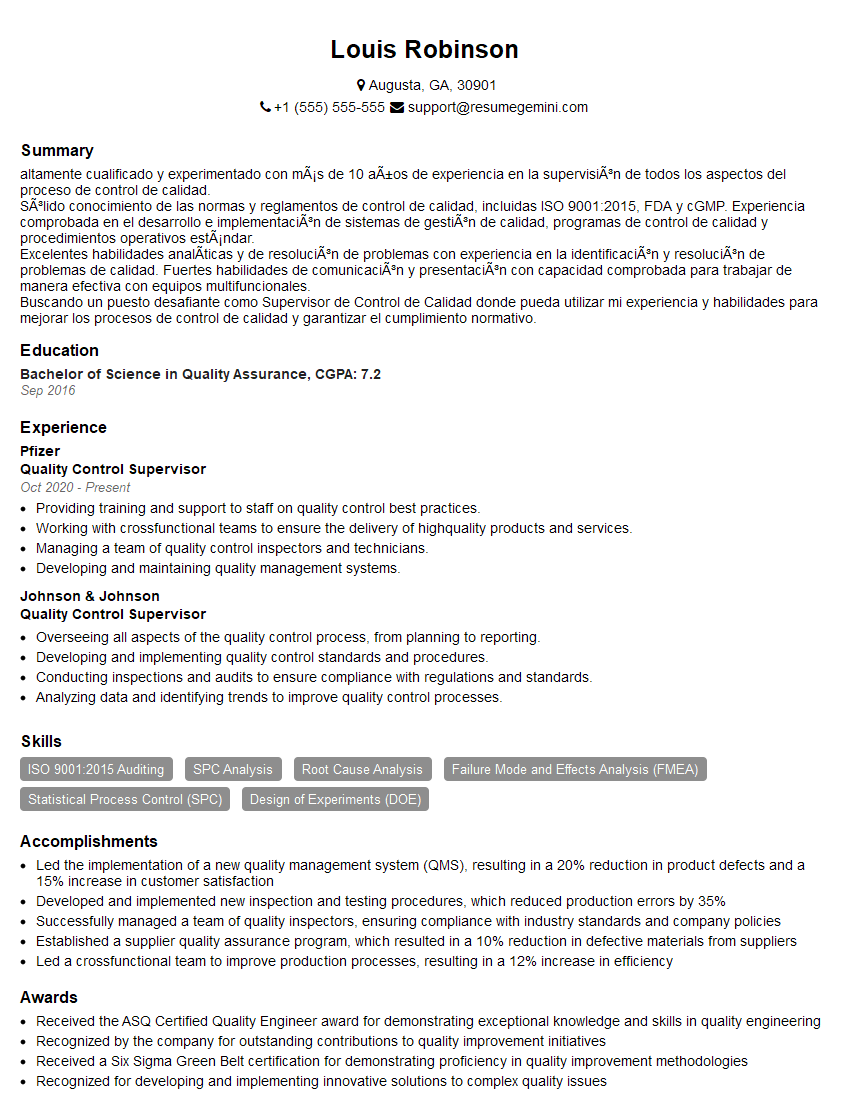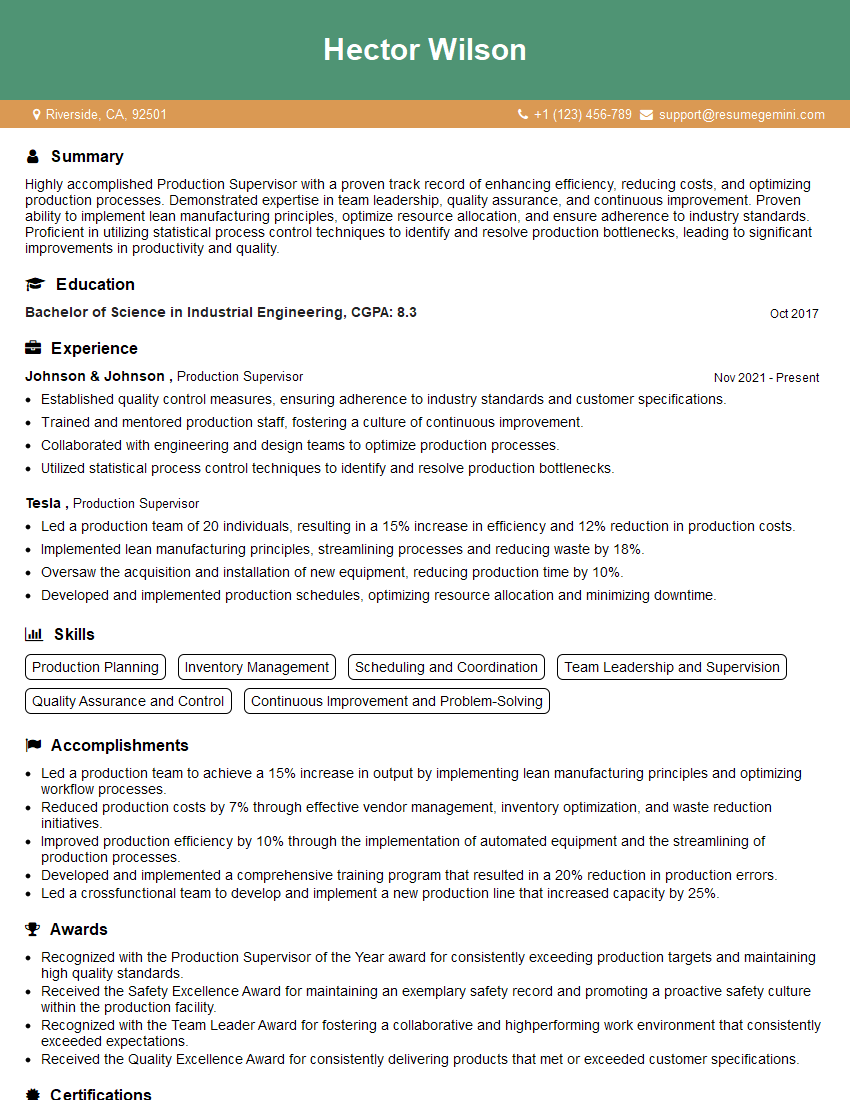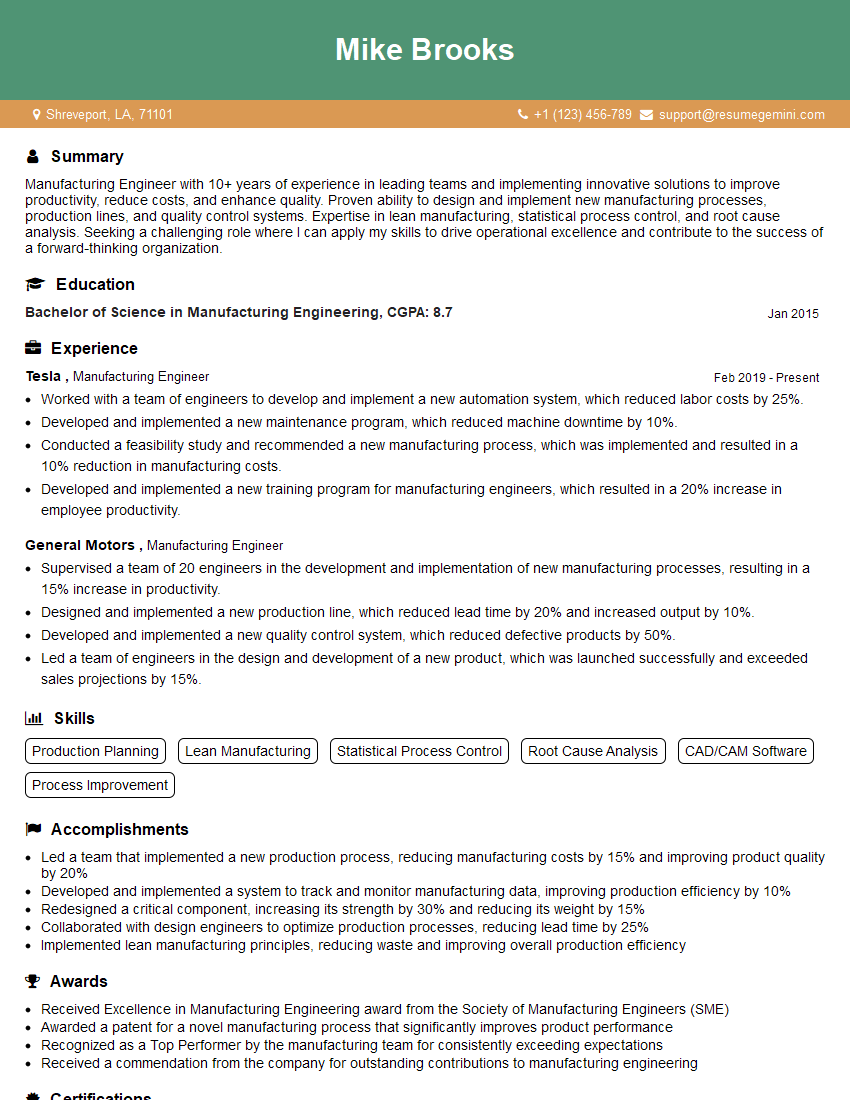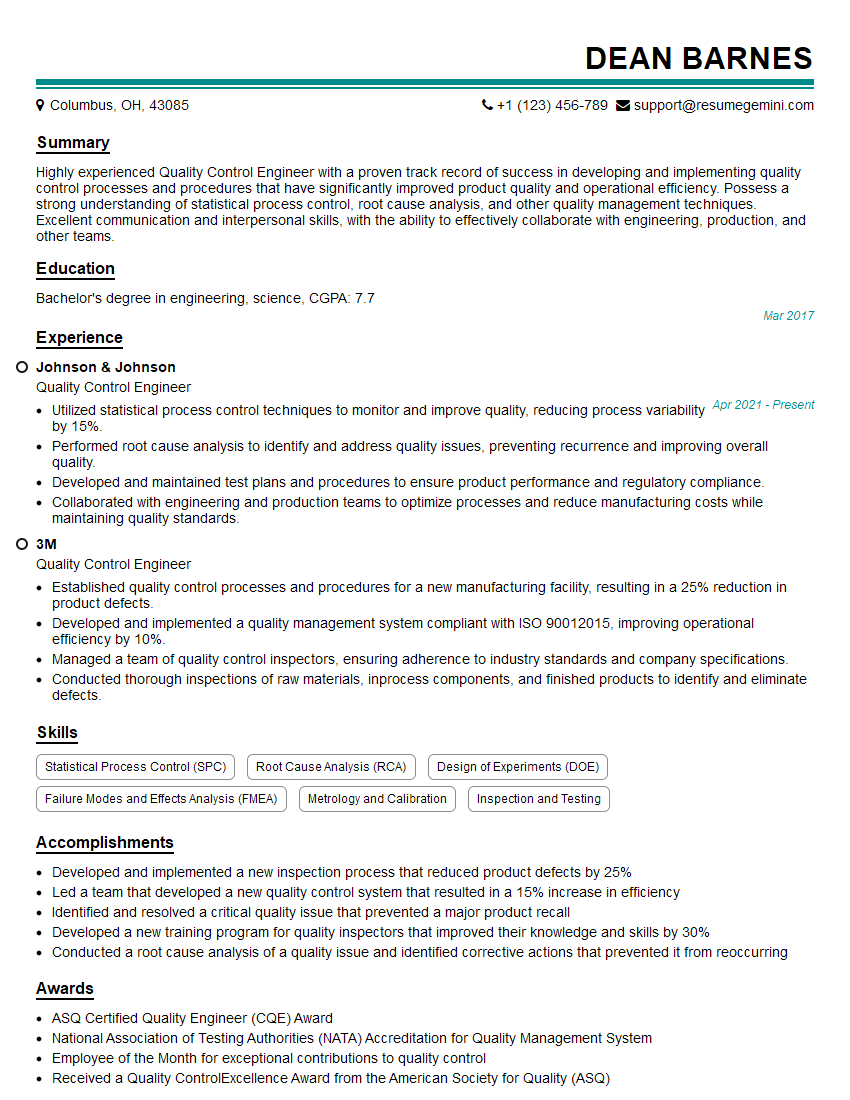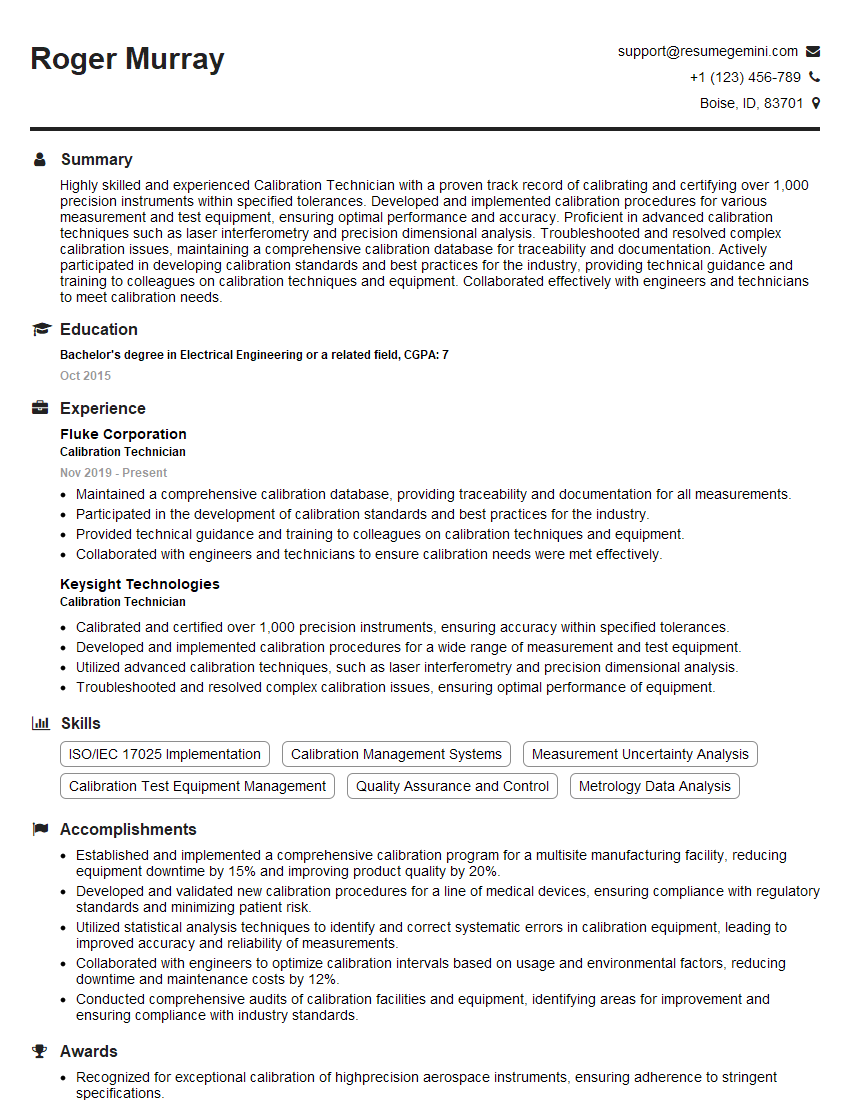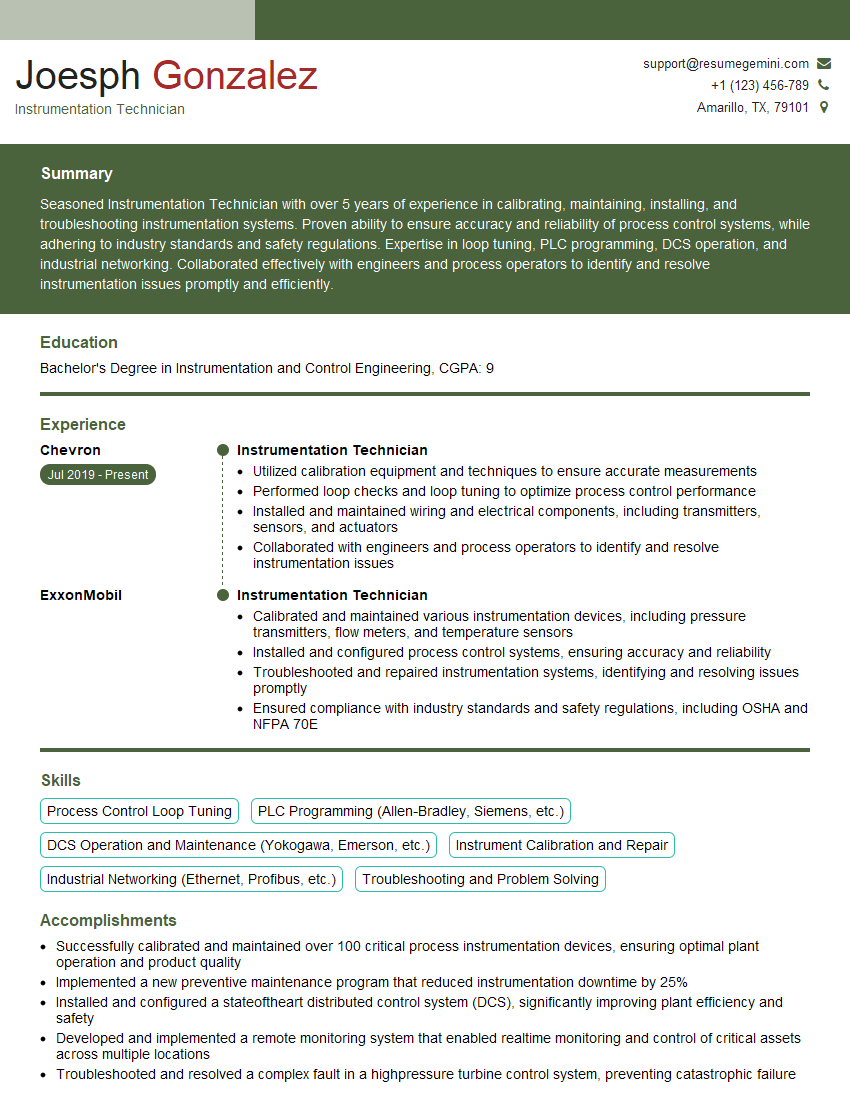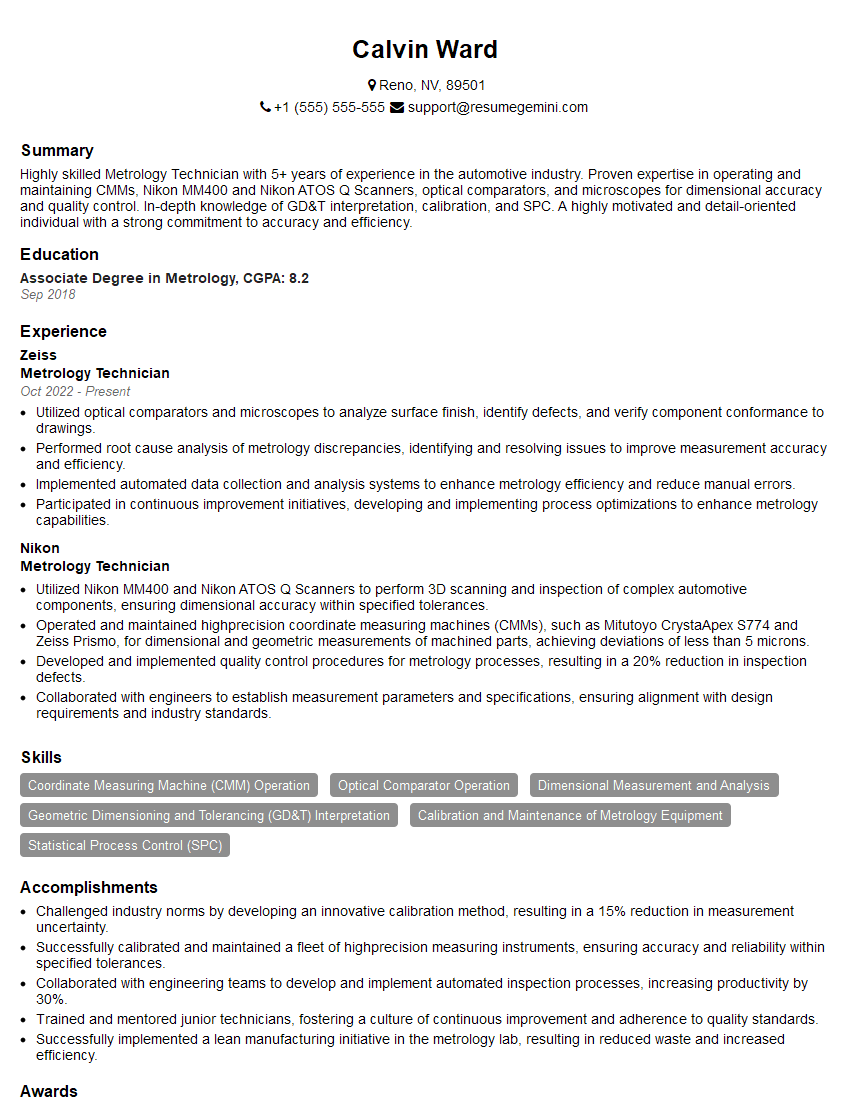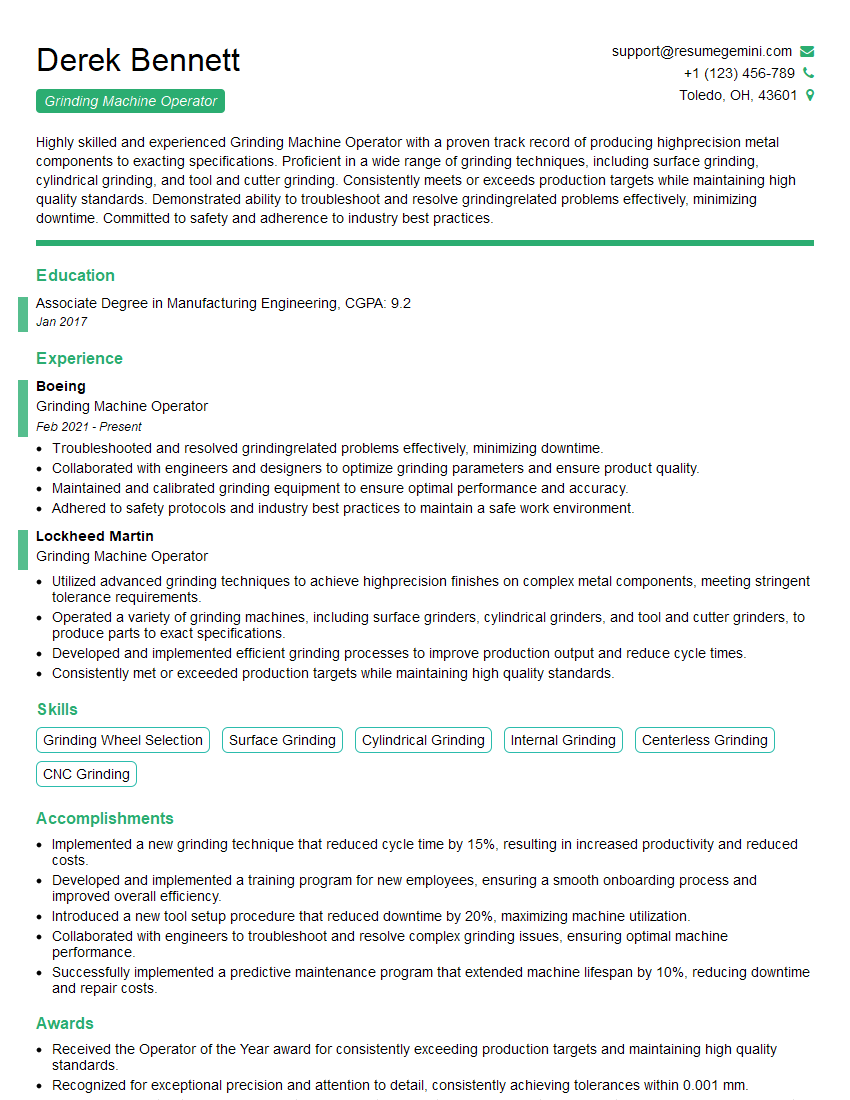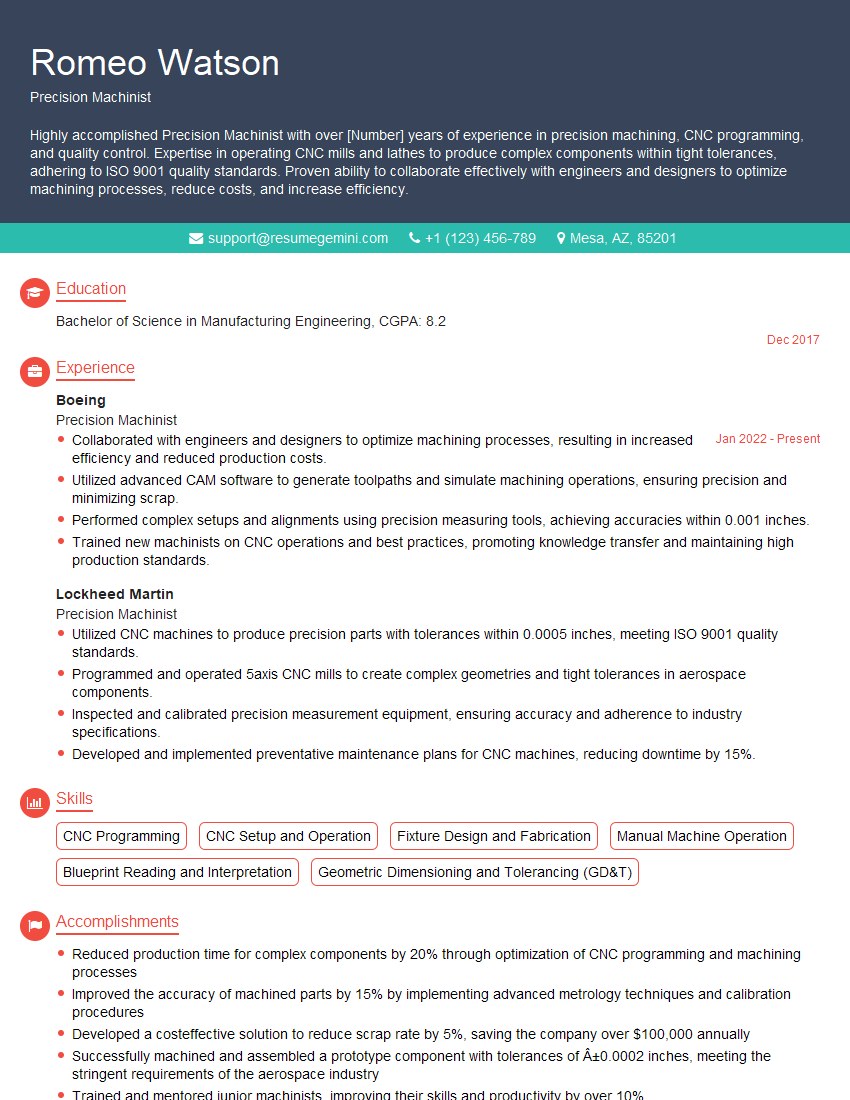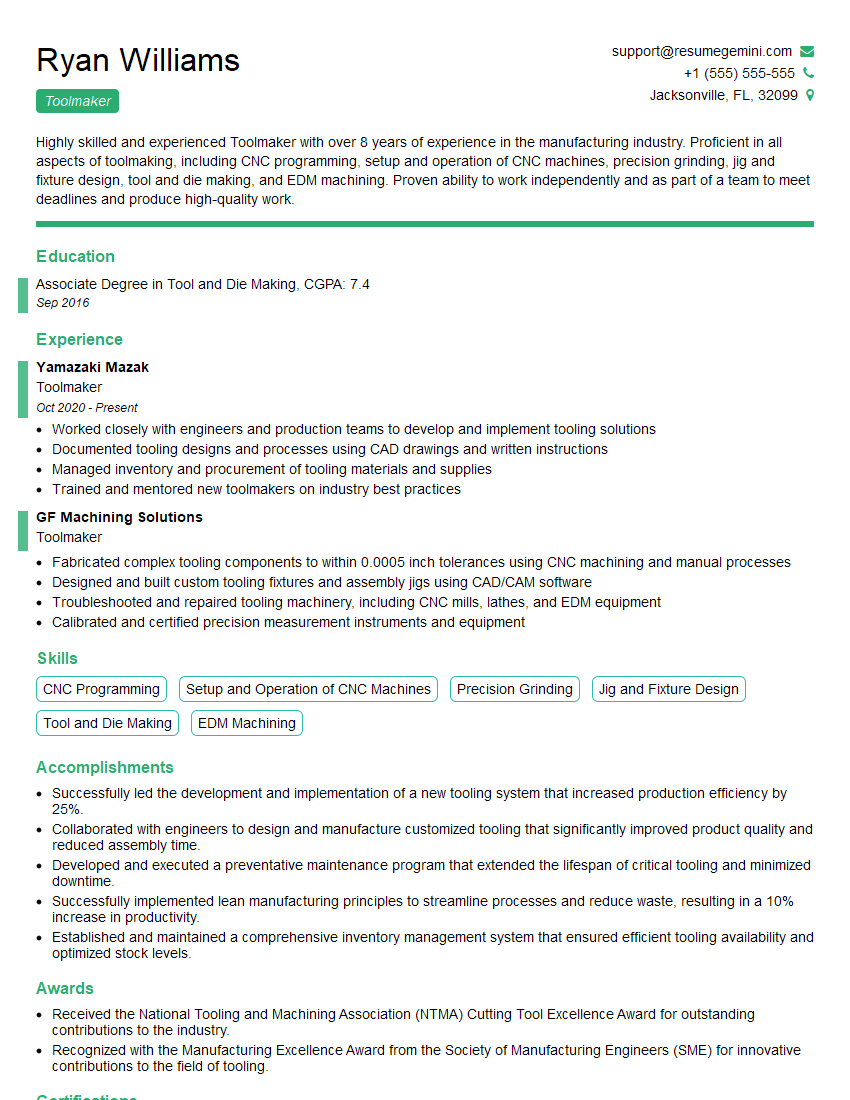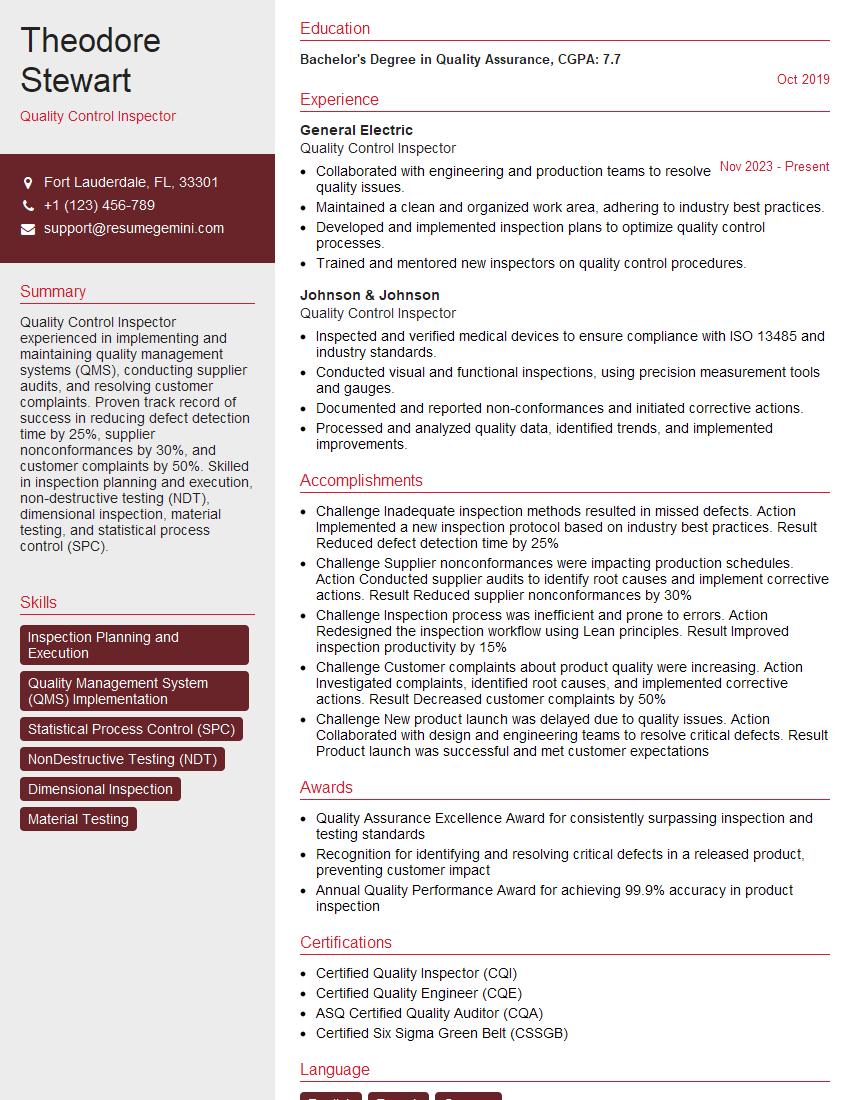Interviews are opportunities to demonstrate your expertise, and this guide is here to help you shine. Explore the essential Gage Grinding interview questions that employers frequently ask, paired with strategies for crafting responses that set you apart from the competition.
Questions Asked in Gage Grinding Interview
Q 1. Explain the process of gage grinding.
Gage grinding is a precision machining process used to create or repair highly accurate measuring tools, known as gages. It involves removing minute amounts of material from a gage’s surface to achieve the desired dimensions and tolerances. This is far more precise than typical grinding, demanding specialized equipment and expertise. The process typically uses a rotating grinding wheel to abrade the gage surface, often under controlled conditions of speed, feed rate, and coolant application.
Think of it like sharpening a pencil, but instead of wood, we’re working with hardened steel or carbide, and instead of aiming for a point, we need incredibly precise, consistent dimensions to within micrometers. The process demands meticulous attention to detail and careful control of various parameters.
Q 2. What types of gages are commonly ground?
Gage grinding encompasses a wide variety of measuring instruments. Commonly ground gages include:
- Plug gages: Cylindrical gages used to check internal diameters.
- Ring gages: Cylindrical gages used to check external diameters.
- Snap gages: Gages with two jaws for quick go/no-go checks of external dimensions.
- Thread gages: Used to check the dimensions and quality of screw threads.
- Profile gages: Used to inspect complex shapes and contours.
- Height gages: Used to precisely measure the height of components.
The specific type of gage dictates the grinding techniques and equipment needed. For instance, grinding a delicate thread gage requires significantly more care than a robust plug gage.
Q 3. Describe different grinding wheel types and their applications in gage grinding.
The choice of grinding wheel is crucial in gage grinding. Different wheel types offer varying characteristics in terms of cutting action, finish, and material removal rate. Here are some examples:
- Aluminum oxide wheels: These are commonly used for general-purpose gage grinding, particularly with ferrous metals. They offer a good balance of cutting speed and surface finish.
- Silicon carbide wheels: These wheels are preferred for grinding non-ferrous materials like brass or aluminum, offering superior performance in these applications. They’re also excellent for achieving finer surface finishes.
- Diamond wheels: These are used for grinding extremely hard materials such as carbide and ceramic gages. Diamond wheels provide exceptional material removal efficiency and high precision.
- CBN (Cubic Boron Nitride) wheels: CBN wheels are another option for extremely hard materials, offering even better performance than diamond wheels in some cases. They are often chosen for their superior wear resistance, especially when working with hardened steels.
The grain size of the wheel also plays a vital role, with finer grain sizes yielding smoother finishes but at a slower material removal rate.
Q 4. How do you select the appropriate grinding wheel for a specific gage material?
Selecting the right grinding wheel depends on several factors related to the gage material:
- Hardness: Harder materials necessitate wheels with a harder bond and potentially diamond or CBN abrasive.
- Material type: Ferrous metals often use aluminum oxide, while non-ferrous metals may require silicon carbide.
- Desired surface finish: Finer surface finishes require finer grain sizes.
- Material removal rate: Higher material removal rates are achieved using coarser wheels, but this may compromise surface quality.
For instance, a hardened steel gage would likely require a diamond or CBN wheel with a relatively fine grain size to maintain dimensional accuracy and a good surface finish. A softer brass gage, however, might be ground with a silicon carbide wheel with a slightly coarser grain for faster material removal.
Q 5. What are the key parameters to control during gage grinding?
Precise control over several parameters is essential for successful gage grinding:
- Wheel speed: Too high a speed can lead to burning or glazing of the gage surface. Too low a speed results in slow material removal.
- Downfeed: The rate at which the gage is fed into the grinding wheel. Too aggressive a feed can cause inaccuracies and damage.
- Coolant application: Coolant prevents overheating and helps maintain surface quality. The type and flow rate of the coolant should be optimized.
- Grinding pressure: Excessive pressure can distort the gage or lead to uneven grinding.
- Wheel dressing: Regularly dressing the wheel ensures consistent cutting performance and prevents uneven wear.
Monitoring these parameters using appropriate instrumentation (e.g., digital readouts on the machine) is crucial for ensuring consistent and accurate results. Think of it as a delicate dance – each parameter needs careful balancing to achieve the desired outcome.
Q 6. Explain the importance of maintaining consistent surface finish in gage grinding.
Maintaining a consistent surface finish is crucial for several reasons:
- Accuracy: An uneven surface can introduce inaccuracies into the measurements taken with the gage.
- Wear resistance: A smooth surface is less prone to wear and tear, extending the life of the gage.
- Repeatability: Consistent surface finish ensures repeatable measurements.
- Reduced friction: Smooth surfaces minimize friction during measurement, improving accuracy and reducing wear.
Imagine trying to measure a part with a rough, uneven gage. The inconsistencies in the gage surface would introduce errors in the measurement, making the gage useless. A consistent surface finish ensures reliable and precise measurements.
Q 7. How do you ensure dimensional accuracy during the gage grinding process?
Dimensional accuracy during gage grinding is achieved through a combination of techniques and practices:
- Precise machine setup: Proper alignment and calibration of the grinding machine are paramount.
- Careful selection of grinding wheels: Using the correct wheel type, grain size, and bond for the gage material is vital.
- Controlled process parameters: Maintaining consistent wheel speed, downfeed, and coolant application prevents errors.
- Regular inspection and measurement: Continuous monitoring with precision measuring instruments is critical for detecting and correcting deviations from the desired dimensions.
- Use of specialized measuring equipment: Instruments like optical comparators and CMMs (Coordinate Measuring Machines) are frequently used to verify dimensional accuracy.
A skilled gage grinder constantly monitors the process and makes minute adjustments to ensure that the final product conforms exactly to the specified tolerances. It’s a blend of technical skill and precision measurement that guarantees accuracy.
Q 8. Describe common gage grinding defects and their causes.
Common gage grinding defects stem from inaccuracies in the grinding process, leading to deviations from the desired dimensions and tolerances. These defects can significantly impact the accuracy of measurements taken with the gage.
- Form Errors: These include irregularities in the gage’s shape, such as taper, bow, or out-of-roundness. Causes include improper machine setup, uneven wheel wear, or workpiece deflection during grinding.
- Size Errors: This refers to the gage being either too large or too small. Causes are numerous and include incorrect setting of the grinding machine, improper wheel selection, or excessive grinding pressure.
- Surface Finish Defects: Poor surface finish, like scratches or pitting, affects measurement accuracy and can be caused by using a worn or improperly dressed grinding wheel, insufficient lubrication, or excessive grinding speed.
- Edge Defects: Burrs, chipping, or rounding of the gage’s edges impair accuracy and are often caused by improper grinding techniques, excessive wheel pressure, or using a dull grinding wheel.
For instance, a slightly tapered plug gage will not accurately measure the diameter of a hole because it will contact only one side, leading to an erroneous reading. A precise understanding of these defects and their underlying causes is crucial for efficient troubleshooting and achieving high-quality gage grinding.
Q 9. What are the safety precautions you take during gage grinding?
Safety is paramount in gage grinding. It involves handling sharp tools and potentially hazardous equipment. My safety procedures include:
- Eye Protection: Always wearing safety glasses or a face shield to prevent eye injuries from flying debris.
- Hearing Protection: Using hearing protection as the grinding process can be quite noisy.
- Proper Clothing: Wearing appropriate clothing, like long sleeves and gloves, to protect skin from sharp edges and sparks.
- Machine Guards: Ensuring all machine guards are securely in place to prevent accidental contact with moving parts.
- Tool Handling: Using appropriate tools carefully and avoiding sudden movements.
- Work Area Cleanup: Regularly cleaning the work area to prevent accidents caused by debris.
- Lockout/Tagout Procedures: Following proper lockout/tagout procedures before performing any maintenance or repairs on the grinding machine.
I always follow established safety protocols and regularly inspect equipment for any potential hazards. A safe work environment directly contributes to precise and error-free gage grinding.
Q 10. How do you measure and inspect a ground gage for accuracy?
Measuring and inspecting a ground gage involves using highly precise instruments to ensure it meets the required specifications. Different methods are used based on the gage type.
- Optical Comparators: For checking overall form and size, optical comparators project a magnified image of the gage onto a screen, allowing for precise measurement against reference templates.
- Coordinate Measuring Machines (CMMs): CMMs provide highly accurate three-dimensional measurements of the gage’s dimensions and form. They are ideal for complex gage geometries.
- Micrometers and Calipers: These are used for basic linear measurements, verifying dimensions like diameter, length, and width.
- Interferometry: This advanced technique uses light interference to measure incredibly small variations in the gage’s dimensions, providing exceptionally high precision.
Inspection involves comparing the measured values against the design specifications. Any deviations outside the acceptable tolerance necessitate corrective actions. For example, using a micrometer to measure a cylindrical plug gage, the reading must fall within the specified tolerance range for the gage to be considered acceptable.
Q 11. What calibration techniques are used for verifying gage accuracy?
Calibration techniques for verifying gage accuracy ensure that the gage measures consistently and correctly. The process involves comparing the gage’s measurements to traceable standards.
- Calibration Standards: Using certified reference standards, like master gages or calibrated blocks, that are traceable to national or international metrology standards.
- Comparison Measurements: Directly comparing the measurements obtained with the gage to the measurements obtained with the calibration standard.
- Statistical Analysis: Using statistical methods to analyze the measurement data, determining the uncertainty of the gage and assessing its conformity to the requirements.
- Calibration Reports: Documenting the calibration process, including the measured values, deviations from the standard, and the overall uncertainty of the gage. These reports help track gage performance over time.
Regular calibration is essential to ensure the continued accuracy of the gage and prevents inaccurate measurements. The frequency of calibration depends on the gage’s usage, criticality, and the required level of accuracy.
Q 12. Explain the concept of tolerance and its importance in gage grinding.
Tolerance in gage grinding refers to the permissible variation in the dimensions of the gage from its nominal (ideal) value. It defines the acceptable range of error. For example, a gage with a nominal diameter of 10mm might have a tolerance of ±0.005mm, meaning the actual diameter can be anywhere between 9.995mm and 10.005mm and still be considered acceptable.
Tolerance is crucial in gage grinding because it directly impacts the accuracy and reliability of the measurements taken with the gage. A tighter tolerance indicates higher precision and better measurement quality, although it’s also more challenging to achieve and potentially more costly. The selection of tolerance depends on the application’s precision requirements. A gage used for critical manufacturing processes will demand a much tighter tolerance compared to one used in less demanding applications. Failing to adhere to the specified tolerances results in inaccurate measurements and can lead to costly errors in manufacturing.
Q 13. Describe different types of gage grinding machines.
Various types of gage grinding machines are employed, each suited to specific gage types and required accuracy levels:
- Cylindrical Grinders: These are commonly used for grinding cylindrical gages, such as plug and ring gages. They use a rotating grinding wheel to grind the external or internal diameter of the gage.
- Centerless Grinders: Used for high-volume production of cylindrical gages, these machines grind the workpiece without the need for a center or chuck.
- Surface Grinders: Used for grinding flat gages, such as surface plates or rectangular blocks. These machines utilize a flat grinding wheel to grind the surface to the required flatness and dimensions.
- Internal Grinders: Specifically designed for grinding the internal diameters of ring gages or other internal features. They use specialized grinding wheels and fixtures to reach the interior surfaces.
- CNC (Computer Numerical Control) Grinders: Advanced machines that are programmed to precisely control the grinding process, offering high accuracy and repeatability. These are used for grinding complex shapes and dimensions.
The choice of machine depends on factors such as the gage’s geometry, required precision, production volume, and budget. CNC grinders are preferred for high-precision, complex shapes, while simpler machines might suffice for basic geometries.
Q 14. How do you troubleshoot common problems encountered during gage grinding?
Troubleshooting in gage grinding involves systematically investigating the causes of defects or inconsistencies in the grinding process.
- Poor Surface Finish: Check for worn or improperly dressed grinding wheels, insufficient lubrication, excessive grinding speed, or incorrect wheel selection.
- Size Errors: Verify the machine’s setup, grinding wheel diameter and wear, workpiece mounting, and grinding pressure. Recalibrate the machine if necessary.
- Form Errors (Taper, Bow): Inspect the machine’s alignment, check for workpiece deflection, ensure proper chucking or support, and inspect the grinding wheel for even wear.
- Edge Defects (Chipping, Burrs): Use appropriate grinding techniques, avoid excessive wheel pressure, use a sharp grinding wheel, and consider using a deburring process.
- Machine Malfunction: Regularly maintain the grinding machine and check for any mechanical or electrical issues.
Troubleshooting often involves a combination of visual inspection, measurement, and understanding the grinding process itself. Following a structured approach to problem identification helps to resolve issues quickly and efficiently. For example, if you are experiencing consistent size errors, check the calibration of the machine and the accuracy of the reference standards used for calibration. A systematic approach and record keeping are vital to preventing recurrence of issues.
Q 15. What are the critical quality characteristics of a precision gage?
The critical quality characteristics of a precision gage hinge on its ability to accurately and reliably measure a specific dimension. This involves several key aspects:
- Accuracy: The gage must consistently measure within a very tight tolerance of the nominal dimension. Any deviation impacts the precision of the parts being measured. Think of it like a perfectly calibrated scale – it must always give the correct weight.
- Repeatability: Repeated measurements of the same part should yield the same result, demonstrating the gage’s consistency and reliability. This is crucial for ensuring quality control.
- Surface Finish: The surface of the gage must be smooth and free from imperfections to avoid damaging the part being measured and ensure accurate contact. Imagine trying to measure something with a rough ruler – you wouldn’t get a precise reading.
- Dimensional Stability: The gage must maintain its dimensions over time and under varying environmental conditions (temperature, humidity). A gage that changes shape is useless for consistent measurements.
- Geometric Accuracy: For complex gages, the angles, parallelism, and other geometric features must be precisely controlled to guarantee reliable measurements. For instance, a thread gage needs perfectly formed threads for a valid measurement.
These characteristics are interconnected; a flaw in one area can significantly affect the others. Strict adherence to these standards is crucial for producing reliable and accurate parts.
Career Expert Tips:
- Ace those interviews! Prepare effectively by reviewing the Top 50 Most Common Interview Questions on ResumeGemini.
- Navigate your job search with confidence! Explore a wide range of Career Tips on ResumeGemini. Learn about common challenges and recommendations to overcome them.
- Craft the perfect resume! Master the Art of Resume Writing with ResumeGemini’s guide. Showcase your unique qualifications and achievements effectively.
- Don’t miss out on holiday savings! Build your dream resume with ResumeGemini’s ATS optimized templates.
Q 16. How do you handle complex or unusual gage grinding requests?
Handling complex or unusual gage grinding requests requires a methodical approach. It begins with a thorough understanding of the requirements, which often involves close collaboration with the engineering team. This might include:
- Detailed Review of Drawings and Specifications: I meticulously examine all dimensions, tolerances, surface finishes, and material specifications. Any ambiguity needs clarification.
- Selection of Appropriate Grinding Wheels and Techniques: The choice of wheel depends on the material, desired finish, and the complexity of the geometry. Specialized wheels might be needed for unusual shapes or hard materials.
- Work Holding Fixture Design and Fabrication: For complex shapes, bespoke work-holding fixtures are often necessary. This requires careful design to ensure proper support and prevent damage during grinding.
- Incremental Grinding and Frequent Inspection: Complex gages are usually ground incrementally, with frequent inspection using advanced measuring equipment (e.g., CMMs, optical comparators) to ensure the part conforms to specifications at each stage.
- Troubleshooting and Adjustment: Unexpected challenges are common. Problem-solving involves adjusting the grinding parameters, modifying the work-holding, or even designing new fixtures to overcome obstacles.
One memorable project involved grinding a gage with intricate internal features. We had to design a custom fixture with multiple clamping points to hold the piece securely during the internal grinding operations and ensure the precise positioning needed for such internal details.
Q 17. Describe your experience with different grinding fluids and their selection.
Grinding fluids play a critical role in gage grinding, impacting surface finish, wheel life, and the overall quality of the finished gage. The selection depends on several factors, including the material being ground, the type of grinding wheel, and the desired surface finish. Here’s what I consider:
- Water-Based Fluids: These are environmentally friendly and are suitable for many applications. However, their cooling capacity might be lower compared to oil-based solutions, especially for hard materials.
- Oil-Based Fluids: These provide excellent cooling and lubrication, ideal for difficult-to-grind materials, but are less environmentally friendly. They also can require more extensive cleanup processes.
- Synthetic Fluids: These offer a balance between performance and environmental friendliness, often providing better cooling than water-based fluids and better environmental profile than oil based.
For example, when grinding hardened steel gages, I usually opt for a high-quality synthetic fluid with excellent lubricity to minimize friction and heat buildup. For softer materials, a water-based fluid with appropriate additives might be sufficient. The fluid’s viscosity, pH, and additives also impact the final product, and choosing the right fluid can be the difference between a smooth, clean part and a damaged one. I always carefully document fluid choice for later traceability and reproducibility.
Q 18. What is the role of dressing and truing in gage grinding?
Dressing and truing are essential maintenance processes that ensure the grinding wheel maintains its shape and sharpness. A dull or incorrectly shaped wheel will lead to inaccurate and inconsistent results.
- Dressing: This process removes small amounts of material from the wheel’s surface to expose sharp cutting edges and restore its profile. It is done periodically to prevent excessive wheel wear and maintain dimensional accuracy.
- Truing: This process precisely shapes the wheel to its original form, ensuring that it cuts accurately and consistently. This is especially important after the wheel has been dressed or significantly worn.
Think of a woodworking chisel. Regular sharpening (dressing) keeps it sharp, while carefully reshaping the blade (truing) keeps it cutting straight. Neglecting these steps with a grinding wheel would lead to a dull, uneven grind and compromise the accuracy of the finished gage.
Q 19. Explain the importance of proper work holding during gage grinding.
Proper work holding is paramount in gage grinding. Inadequate support can lead to inaccuracies, chatter, and even damage to the gage. The work-holding fixture must:
- Securely Clamp the Gage: The fixture must firmly hold the gage without causing deformation or stress. This means using appropriate clamping forces and strategically placing clamps to avoid distortion.
- Ensure Accurate Positioning: The gage must be precisely positioned to ensure the correct surfaces are ground to the required specifications. This often involves using precision locating pins or other alignment features.
- Protect the Gage from Damage: The work-holding fixture must protect delicate features and prevent scratches or other damage to the gage’s surface during grinding.
- Allow for Easy Loading and Unloading: The fixture should be designed for efficient loading and unloading of the gage to increase overall throughput.
Poor workholding was the root of a problem once; a gage was slightly distorted due to improper clamping pressure resulting in a costly rework. Since then, we emphasize rigorous design and testing of fixtures before use.
Q 20. How do you maintain and clean gage grinding equipment?
Maintaining and cleaning gage grinding equipment is vital for ensuring accuracy, longevity, and safety. My routine includes:
- Regular Cleaning: After each use, I thoroughly clean the machine, removing all metal chips, grinding fluids, and debris. This prevents contamination and prolongs the life of components.
- Wheel Inspection and Change: Grinding wheels need periodic inspection for wear and damage. Worn or damaged wheels must be replaced promptly to maintain accuracy.
- Fluid Management: Grinding fluids need to be changed regularly to maintain their effectiveness and prevent contamination. Spent fluids are disposed of according to environmental regulations.
- Lubrication: Moving parts require regular lubrication to ensure smooth operation and prevent wear. This includes way wipers, guideways, and other mechanical components.
- Calibration and Testing: The machine’s accuracy needs to be verified periodically through calibration using precision standards. This ensures the machine meets the required accuracy standards.
Preventive maintenance like this prevents unexpected downtime and ensures the continued production of high-quality gages. It’s better to address a small issue during routine maintenance than to deal with a major breakdown in the middle of a production run.
Q 21. How do you interpret engineering drawings and specifications for gage grinding?
Interpreting engineering drawings and specifications is the foundation of accurate gage grinding. My process involves:
- Identifying Key Dimensions and Tolerances: I carefully review the drawings to identify all critical dimensions, including tolerances (plus/minus values indicating acceptable variations). This is fundamental to ensuring the gage meets the required accuracy.
- Understanding Surface Finish Requirements: Drawings specify surface roughness (Ra values), which determines the final surface quality of the gage. This influences the choice of grinding wheel and fluid.
- Analyzing Geometric Features: Many gages have complex geometric features (angles, tapers, radii). Accurate interpretation of these features is crucial for precise grinding.
- Material Specification: The material of the gage influences the grinding process. Hard materials require different techniques and wheels than softer ones. This involves a full understanding of material properties.
- Verification of Drawings: Sometimes the drawings contain ambiguities or conflicts. If I find such issues, I consult with the engineering team to clarify these aspects.
Once I completely understand the drawing, I can create a detailed grinding plan which minimizes errors and improves production efficiency. Overlooking any detail could lead to a non-functional or out-of-spec part. Clear communication and thorough interpretation are essential.
Q 22. What software or systems have you used for gage grinding or metrology?
Throughout my career, I’ve utilized a variety of software and systems for gage grinding and metrology. This includes dedicated gage grinding machine controllers with built-in software for programming and monitoring the grinding process, such as those found on machines from companies like Mitutoyo and ANCA. These systems often include features for precise control of parameters like wheel speed, feed rate, and depth of cut. I’m also proficient in using metrology software packages, including PolyWorks and CMM-specific software that allows for the programming of inspection routines and the analysis of measured data. These packages enable me to create detailed inspection plans, generate reports, and assess the quality of the finished gages based on specified tolerances. My experience also encompasses using data acquisition systems to interface with various measuring instruments, capturing and processing data for statistical process control (SPC) analysis to ensure consistent quality across multiple gage production runs.
Q 23. Describe your experience with different types of gage materials (steel, carbide, etc.)
My experience spans various gage materials, each with its own unique properties and challenges. Steel, the most common material, offers a good balance of strength, wear resistance, and machinability. However, its susceptibility to rust requires careful surface treatments. Carbide, a much harder material, is preferable for high-precision applications and applications where extended tool life is critical, particularly where high volumes of parts need to be inspected. The hardness of carbide requires specialized grinding techniques and equipment. I’ve also worked with tool steels that offer improved hardness and wear resistance compared to standard steel. Selection of the appropriate material depends critically on factors like the application’s required accuracy, expected life of the gage, the materials being measured, and the budget. For instance, a gage for checking a very hard material, like hardened steel, would require a gage material of comparable or higher hardness, making carbide a preferable choice.
Q 24. What is your experience with CMM (Coordinate Measuring Machine) inspection?
I have extensive experience with CMM inspection, utilizing both manual and automated CMM systems. My expertise encompasses programming CMMs using various software packages to inspect complex geometries and features to exacting tolerances. This involves creating inspection routines, defining measurement points, and analyzing the resulting data to determine conformance to specifications. I’m adept at interpreting CMM reports, identifying sources of variation, and troubleshooting measurement issues. For example, I’ve used CMMs to verify the dimensional accuracy of precision cylindrical gages, ensuring that the diameter, length, and roundness fall within the acceptable range. I’m also experienced in using statistical methods for data analysis, such as generating control charts and performing capability studies, to ensure the reliability of the CMM inspection process and identify potential problems early on.
Q 25. Explain the difference between cylindrical and flat gage grinding.
Cylindrical and flat gage grinding differ significantly in their techniques and equipment. Cylindrical gage grinding involves machining cylindrical parts to precise diameters and lengths, typically using specialized grinders with rotating workpieces and grinding wheels. These machines often employ advanced features like automatic in-process gaging to ensure the desired dimensions are consistently achieved. Flat gage grinding, on the other hand, focuses on producing flat surfaces with highly precise parallelism and flatness. This generally involves surface grinders equipped with magnetic chucks to hold the workpieces securely during grinding. The grinding process is carefully controlled to achieve the desired surface finish and flatness. Think of it this way: cylindrical gage grinding is like making a perfectly round pencil, while flat gage grinding is like making a perfectly flat and parallel tabletop. Each requires different skills and machinery optimized for the specific geometry.
Q 26. How do you manage your time effectively during the gage grinding process?
Effective time management in gage grinding is crucial for meeting deadlines and maintaining quality. I prioritize tasks based on urgency and complexity, using a combination of planning tools and efficient work practices. Before starting a project, I carefully review the specifications, including tolerances, surface finish requirements, and the material being used. I then plan the grinding process, including the selection of grinding wheels, coolants, and the sequence of operations. During the grinding process, I continuously monitor the progress and make adjustments as needed. I also maintain a clean and organized workspace to minimize interruptions and improve efficiency. Moreover, I use various quality control measures throughout the process to reduce the need for rework or scrap. Finally, proper documentation of each step is key to traceability and for problem-solving in the future.
Q 27. Describe a challenging gage grinding project you successfully completed.
One particularly challenging project involved grinding a set of carbide plug gages with extremely tight tolerances (plus/minus 0.00005 inches) and a mirror-like surface finish. The challenge lay in achieving the specified accuracy and surface finish with carbide, a material that is notoriously difficult to grind. The project required careful selection of the grinding wheel, optimized grinding parameters, and precise control of the grinding process. We employed a high-precision cylindrical grinder equipped with advanced feedback systems to monitor the grinding process and maintain consistency. Multiple iterative steps of grinding and measuring using a high-resolution CMM ensured we iteratively approached the specified tolerance. Through meticulous planning, precise execution, and constant monitoring, we successfully completed the project on time and within the required specifications. This project highlighted the importance of meticulous planning and expertise in selecting the appropriate grinding parameters, wheel selection, and using advanced measuring technologies.
Q 28. What are your future goals related to gage grinding and metrology?
My future goals center on advancing my expertise in precision gage grinding and metrology. I aim to expand my knowledge of advanced grinding techniques, such as creep feed grinding, and explore new materials and technologies. I’m particularly interested in exploring the integration of advanced automation and data analytics in the gage grinding process to improve efficiency, consistency, and quality. I also hope to contribute to the development of new standards and best practices in the field of gage grinding and metrology, sharing my expertise to raise the industry bar.
Key Topics to Learn for Gage Grinding Interview
- Understanding Gage Block Standards: Learn about various gage block standards (e.g., ANSI, ISO) and their implications for precision measurement.
- Grinding Techniques and Processes: Familiarize yourself with different grinding methods used in gage block manufacturing, including their advantages and limitations (e.g., surface grinding, cylindrical grinding).
- Abrasive Selection and Application: Understand the properties of different abrasives and how to select the appropriate ones for achieving desired surface finishes and tolerances in gage grinding.
- Precision Measurement and Calibration: Master the principles of precise measurement using various instruments (e.g., interferometry, comparators) and understand the importance of calibration in ensuring accuracy.
- Quality Control and Inspection: Learn about the quality control procedures involved in gage grinding, including inspection techniques and the interpretation of measurement data.
- Troubleshooting and Problem Solving: Develop your ability to identify and solve common problems encountered during the gage grinding process, such as surface defects or dimensional inaccuracies.
- Health and Safety Procedures: Understand and be prepared to discuss the safety protocols and regulations relevant to gage grinding operations.
- Material Science: Gain a foundational understanding of the materials typically used in gage blocks and their impact on grinding performance.
- Machine Operation and Maintenance: Demonstrate familiarity with the operation and basic maintenance of relevant grinding machines and equipment.
Next Steps
Mastering Gage Grinding opens doors to specialized and highly sought-after roles in precision engineering and manufacturing. A strong understanding of these principles significantly boosts your career prospects. To increase your chances of landing your dream job, crafting an ATS-friendly resume is crucial. ResumeGemini is a trusted resource that can help you build a professional and impactful resume that highlights your skills and experience effectively. Examples of resumes tailored to Gage Grinding are available to guide you. Invest in building a compelling resume today – it’s your key to unlocking exciting opportunities.
Explore more articles
Users Rating of Our Blogs
Share Your Experience
We value your feedback! Please rate our content and share your thoughts (optional).
What Readers Say About Our Blog
There are no reviews yet. Be the first one to write one.
